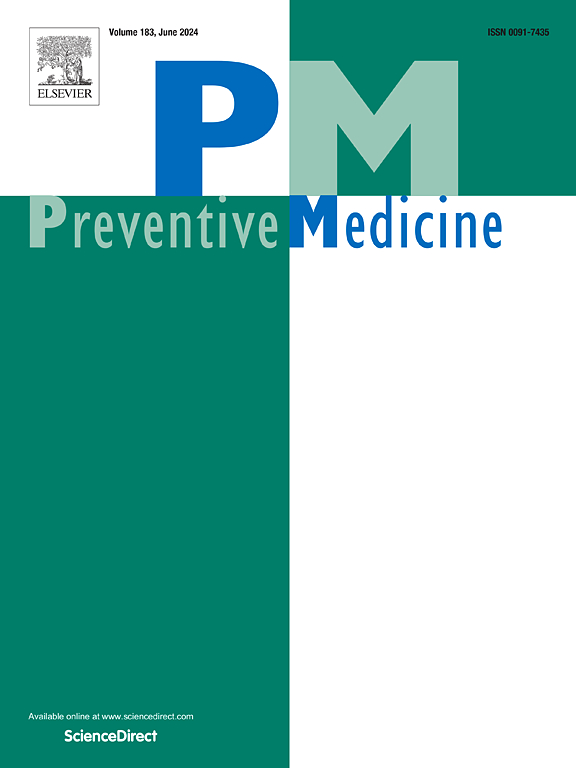Sex differences in tobacco use, attempts to quit smoking, and cessation among dual users of cigarettes and e-cigarettes: Longitudinal findings from the US Population Assessment of Tobacco and Health Study
IF 4.3
2区 医学
Q1 MEDICINE, GENERAL & INTERNAL
引用次数: 0
Abstract
Significance
A growing number of adults use more than one tobacco product, with dual use of cigarettes and e-cigarettes being the most common combination. Monitoring sex disparities in tobacco use is a public health priority. However, little is known regarding whether dual users differ by sex.
Methods
Data came from Waves 4–6 (12/2016–11/2021) of the Population Assessment of Tobacco and Health Study, a US nationally-representative longitudinal survey. This analysis included current adult dual users of cigarettes and e-cigarettes. We used weighted generalized estimating equations to assess the association between sex and (1) making a cigarette quit attempt (n = 1882 observations from n = 1526 individuals) and (2) smoking cessation (n = 2081 observations from n = 1688 individuals) across two wave pairs, adjusting for age, education, ethnicity, time-to-first cigarette after waking, and e-cigarette use frequency.
Results
Among US dual users, 14.1% (95% Confidence Intervals [Cl] = 11.9–16.4) of females and 23.4% (20.0–26.9) of males were young adults (aged 18–24), 11.7% (9.2–14.2) of females and 14.4% (11.6–17.2) of males had <high school education, and 82.2% (79.4–84.5) of females and 78.7% (75.1–82.4) of males were white. Overall, 44.9% (41.6–48.1) of females compared with 37.4% (33.5–41.3) of males made an attempt to quit smoking between a baseline and follow-up wave (Adjusted Risk Ratio [ARR] = 1.23, 1.05–1.45). In contrast, there were no apparent differences between females (22.1%, 19.0–25.2) and males (24.3%, 21.5–27.1) in smoking cessation (ARR = 1.06, 0.84–1.35).
Conclusion
US females who dually use e-cigarettes and cigarettes were more likely to attempt to quit smoking, but not more likely to succeed at quitting, than males.
香烟和电子烟双重使用者在烟草使用、戒烟尝试和戒烟方面的性别差异:美国烟草与健康人口评估研究的纵向发现。
意义重大:越来越多的成年人使用一种以上的烟草产品,最常见的组合是同时使用香烟和电子烟。监测烟草使用的性别差异是公共卫生的当务之急。然而,人们对双重使用者在性别上是否存在差异知之甚少:数据来自美国全国代表性纵向调查 "烟草与健康人群评估研究 "的第 4-6 波(2016 年 12 月至 2021 年 11 月)。这项分析包括当前的卷烟和电子烟双重使用者。我们使用加权广义估计方程来评估性别与(1)尝试戒烟(n = 1526 人中的 1882 个观测值)和(2)戒烟(n = 1688 人中的 2081 个观测值)之间的关联,并对年龄、教育程度、种族、起床后第一次吸烟的时间和电子烟使用频率进行了调整:在美国的双重使用者中,14.1%(95% 置信区间 [Cl] = 11.9-16.4)的女性和 23.4%(20.0-26.9)的男性为年轻成年人(18-24 岁),11.7%(9.2-14.2)的女性和 14.4%(11.6-17.2)的男性为康奈尔人:与男性相比,同时使用电子烟和香烟的美国女性更有可能尝试戒烟,但成功戒烟的可能性并不大。
本文章由计算机程序翻译,如有差异,请以英文原文为准。
求助全文
约1分钟内获得全文
求助全文
来源期刊

Preventive medicine
医学-公共卫生、环境卫生与职业卫生
CiteScore
7.70
自引率
3.90%
发文量
0
审稿时长
42 days
期刊介绍:
Founded in 1972 by Ernst Wynder, Preventive Medicine is an international scholarly journal that provides prompt publication of original articles on the science and practice of disease prevention, health promotion, and public health policymaking. Preventive Medicine aims to reward innovation. It will favor insightful observational studies, thoughtful explorations of health data, unsuspected new angles for existing hypotheses, robust randomized controlled trials, and impartial systematic reviews. Preventive Medicine''s ultimate goal is to publish research that will have an impact on the work of practitioners of disease prevention and health promotion, as well as of related disciplines.
 求助内容:
求助内容: 应助结果提醒方式:
应助结果提醒方式:


